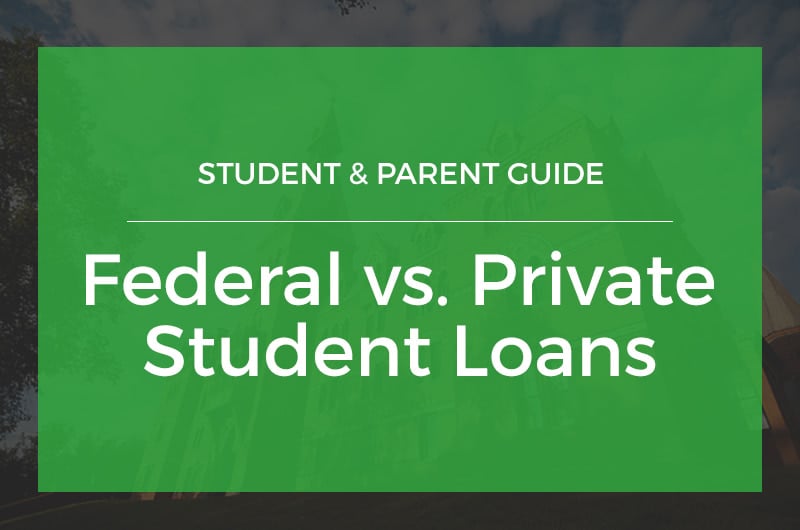
The cost of college can be scary–there’s no doubt about that.
But, it doesn’t have to be unbearable. There are many ways for students and their parents to finance a top-quality education, even if it may seem out of reach.
Aside from cash/savings, scholarships, and grants, there are two main funding options to pay for college:
- Federal loans
- Private loans
In almost all cases, it is advisable to first use federal loan programs to finance the cost of college. But, many students either choose to use private loans or end up taking out a mix of private and federal loans to cover the full cost of college.
This guide will help you to understand the basics of each loan type, see which options are available to you, and then make an educated decision about which one is best.
Pay for college with federal student loans
These loans, issued by the U.S. Department of Education, have very specific underwriting and borrowing criteria, which the student or their parent must meet in order to qualify. Once issued, these loans are generally serviced by one of a number of loan servicing companies and not directly by the federal government.
As mentioned above, most students will choose to pursue federal loans as their main funding source for student loans.
There are a number of reasons why this decision is advisable, but the “best” choice will ultimately depend on the types of federal loan programs that are available to you and what your other options might be.
Types of federal loans
There are a number of federal loan programs available to students and their parents, depending on the circumstances of the family. Some loan programs come with financial restraints (e.g., demonstrated financial need) and others have caps on the maximum amount a student is allowed to borrow per academic year.
Here’s a break down of all of the available federal loan programs:
| Loan program | Details |
|---|---|
| Federal Direct Subsidized |
|
| Federal Direct Unsubsidized |
|
| Federal Perkins |
|
| Federal PLUS |
|
Incredibly important note: In order to qualify for these federal loan programs, you will need to complete the FAFSA!
Benefits of federal loans
Most students will find their federal loan offers included as part of their financial aid award letter from the colleges to which they have applied. As such, they’re almost always used as the “first line” for paying college costs.
And for good reason. The federal loan programs that are offered are generally very favorable for most students and parents.
The main benefits of choosing a federal loan are:
- Guaranteed acceptance for some loan programs
- Relatively low interest (may not be best in the market)
- Federal loan protections like deferment and forbearance
- Subsidized loan options for some students
- Forgiveness and income-based repayment options available upon graduation
- Ease–little or no comparison shopping needed
Drawbacks of federal loans
- Hard borrowing limits
- No flexibility in underwriting criteria
- Interest rates may not reflect market rates
- Many programs require demonstrated financial need
Pay for college with private student loans
Many students attempt to avoid private student loans
While there aren’t different loan programs from private lenders (generally) in the same way that there are for federal loans, there are a number of different sources of private loans.
Some students receive private loans from their local credit union, others go to national banks.
If you’re looking for a private loan to help pay for college, you’ll want to closely evaluate your loan options to make sure that you find the right loan for you.
Benefits of private loans
- Generally no borrowing limits on funds
- Market-based interest rates may be lower
- Often have extra perks of benefits
Drawbacks of private loans
- Require a credit check
- May require a cosigner
- Some lenders don’t offer borrower protections
Finding a private student loan company
One challenge with using private student loans is finding the right lender. Not all banks offer private student loans, and many of them do not offer competitive rates.
Luckily, there are a number of new sites and technology that can help you find the right loan to pay for school.
The two websites Credible and LendKey allow you to compare rate offers from multiple lenders to see which one offers the best deal–without doing a credit check.
Credible aggregates and compares offers from about 8 lenders.
LendKey focuses on regional and local not-for-profit credit unions and community banks.
Check them out:
| Rates | Terms | Eligible Degrees | ||
|---|---|---|---|---|
 Compare rate offers from about 8 lenders | 1.04%* + variable APR 3.30%* + fixed APR | 5 - 15, 20 years | Undergrad & Grad | LEARN MORE › |
 | 1.13% - 11.23% variable APR 3.50% - 12.60% fixed APR | 5, 10, 15 years | Undergrad & Grad | LEARN MORE › |
*APR includes a 0.25% interest rate reduction for enrollment in automatic payments.



